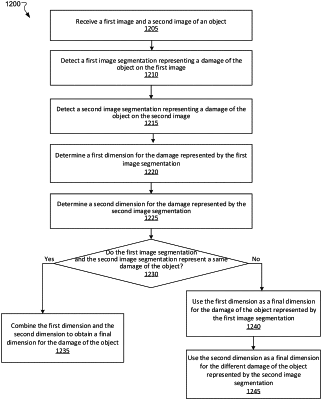| CPC G06T 7/0002 (2013.01) [G06F 18/22 (2023.01); G06T 7/11 (2017.01); G06T 7/62 (2017.01); G06T 2207/20081 (2013.01); G06T 2207/20221 (2013.01); G06T 2207/30252 (2013.01)] | 20 Claims |

|
1. A method for dimension estimation based on duplicate instance identification, the method comprising:
receiving a set of images of an object;
detecting, using a first machine learning system trained to perform image segmentation, from a first image in the set of images, a first image segmentation representing a damage of the object on the first image;
detecting, using the first machine learning system trained to perform image segmentation, from a second image in the set of images, a second image segmentation representing a damage of the object on the second image;
determining, using a second machine learning system trained to perform dimension estimation, a first dimension for the damage represented by the first image segmentation and a second dimension for the damage represented by the second image segmentation;
determining whether the first image segmentation and the second image segmentation represent a same damage of the object based on a similarity index between the first image segmentation and the second image segmentation; and
responsive to determining that the first image segmentation and the second image segmentation represent the same damage, intelligently combining the first dimension and the second dimension to obtain a final dimension for the damage of the object.
|